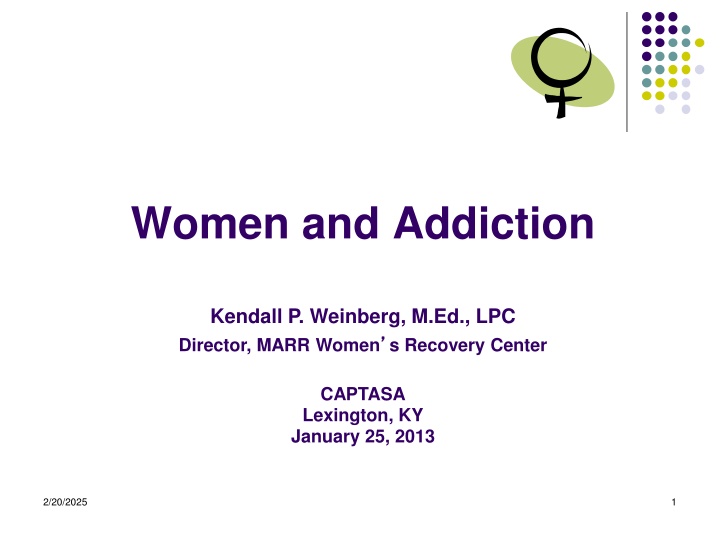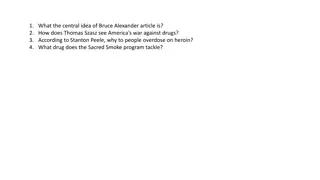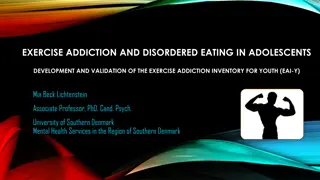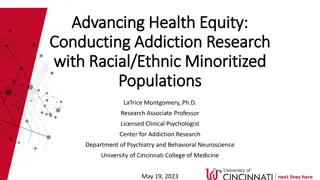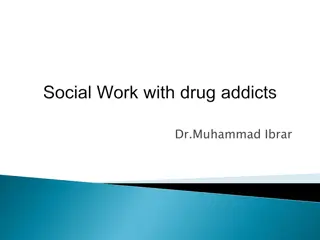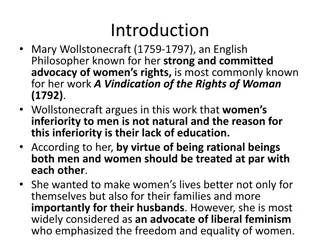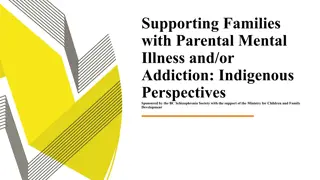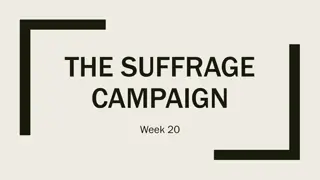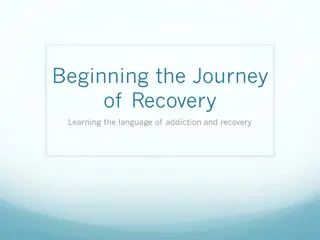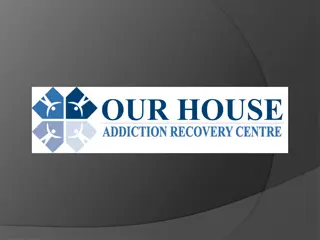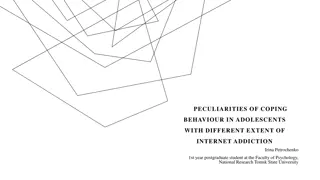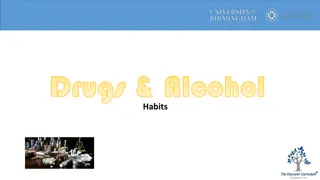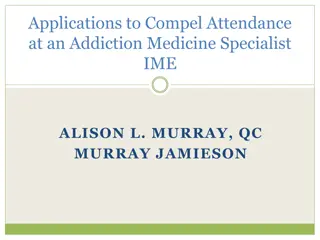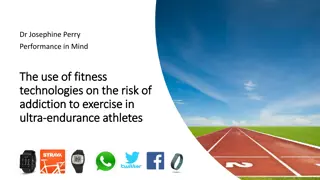Women and Addiction
This content delves into the complex landscape of addiction and recovery in women, highlighting the challenges, stigma, and factors contributing to addiction. It emphasizes the importance of addressing shame, resilience, and self-compassion in the journey towards healing and overcoming addiction.
Uploaded on Feb 20, 2025 | 0 Views
Download Presentation

Please find below an Image/Link to download the presentation.
The content on the website is provided AS IS for your information and personal use only. It may not be sold, licensed, or shared on other websites without obtaining consent from the author.If you encounter any issues during the download, it is possible that the publisher has removed the file from their server.
You are allowed to download the files provided on this website for personal or commercial use, subject to the condition that they are used lawfully. All files are the property of their respective owners.
The content on the website is provided AS IS for your information and personal use only. It may not be sold, licensed, or shared on other websites without obtaining consent from the author.
E N D
Presentation Transcript
Women and Addiction Kendall P. Weinberg, M.Ed., LPC Director, MARR Women s Recovery Center CAPTASA Lexington, KY January 25, 2013 2/20/2025 1
2/20/2025 2/20/2025 2 2
The Spiral of Addiction and Recovery (Covington, 1997) Transformation Recovery (expansion) Addiction (constriction) Alone in their homes, they simply pulled the shades down, stopped answering the phone and disappeared into their ever contracting world. (Dayton, 2003) 2/20/2025 3
Why do we need this lecture? Research including female subjects is still fairly new - 8% Rates of addiction/alcoholism females 12-17 mirror rates for males Booming senior population - Recognition / Over prescribing Factors contributing to addiction / recovery more complex for females Feminization of Higher Education = more impaired female professionals in healthcare and professional settings Good moms don t use drugs and alcohol Shame kills and stigma still more prevalent for female addicts/alcoholics 2/20/2025 4
SHAME 2/20/2025 5
SHAME *Connections: A 12-Session Psychoeducational Shame-Resilience Curriculum. Bren Brown, Ph.D., LMSW, 2009 Who do you think you are? Unworthy, unlovable, incapable, inadequate, broken, weak, flawed You ll never be good enough. Hide your faults, disappear, pretend to be perfect, or transform into what others expect of you. 2/20/2025 6
Keys to Shame Resilience *Connections: A 12-Session Psychoeducational Shame-Resilience Curriculum. Bren Brown, Ph.D., LMSW, 2009 Authenticity Emotionally honest, set boundaries, be vulnerable Exercise compassion for self / others Let go of what we are supposed to be; Embrace who we are Love and Belonging Internal sense of belonging vs. Search for external acceptance / approval Trying to fit in or be cool gets in the way of true belonging We are worthy of love; allow ourselves to be deeply seen / known Love the ordinary and imperfect parts of ourselves Practice forgiveness and self-compassion A Resilient Spirit Tell our stories practicing hope & gratitude while embracing vulnerability Honor faith and intuition Value perseverance and rest Hold joy and laughter sacred 2/20/2025 7
Women and Addiction Physiological Factors Evolutionary Psychological Factors Relationship Factors Considerations for Treatment of Female Addicts 2/20/2025 8
Physiological Factors All fetal brains are structured as female until 8 weeks gestation Females = sprout connections in communication / emotion centers 11% more neurons Males = MIS + Testosterone defeminize brain structure; growth in sex / aggression centers Females have a larger Hippocampus Hub for emotion & memory formation / fight or flight response Females better equipped to read facial expressions / hear vocal tones 1st 3 months girls skills in eye contact / facial gazing increase 400% Little to no increase for boys; increased ability to track objects in motion Difference in Serotonin systems Prevalence of mood / anxiety disorders for women Females become intoxicated faster / addicted faster (Telescoping) Mortality rates are higher for female substance abusers (50-100x) 2/20/2025 9
Physiological Factors: Hormonal Shifts Estrogen: Promotes social interest Provides a sense of well-being Causes one to feel more socially relaxed Causes one to seek intimacy with others Spikes during the 1st two weeks of monthly cycle Testosterone: Trigger for sexual desire Men have on avg. 10-100x more testosterone than women 2/20/2025 10
Physiological Factors: Hormonal Shifts Progesterone: Causes increased irritability Causes women to seek aloneness Increases reactivity to relationship stress Curbs sexual desire Peaks during 2nd half of monthly cycle 2/20/2025 11
Progesterone Peaks Estrogen & Testosterone peak
Physiological Factors: Hormonal Shifts Oxytocin: Triggers / Is triggered by intimacy the cuddle hormone Reduces stress Estrogen fuels Oxytocin and Dopamine (REWARD!) production Oxytocin / Dopamine = PLEASURE akin to cocaine or heroin (+) Chemical reaction of being In Love INTENSE shares neural circuits with states of obsession, mania, intoxication, thirst, hunger REJECTION = Drop in Oxytocin / Dopamine / Estrogen (-) chemical reaction mimics withdrawalsymptoms Relationships = huge relapse risk factor in all stages of recovery 2/20/2025 13
Evolutionary Psychological Factors: Our modern skulls house a stone age mind Females Males Connection = Survival Achievement = Survival Connection requires honed social skills Achievement requires competition Conflict alerts that connection may be threatened; out of group? SHAME? Conflict may provide opportunity to secure elevated status within group Security: Use ability to read faces, discern vocal tones, anticipate others needs and respond to unspoken cues Security: Increased social status allows easier defense of territory / leverage of power / obtain resources Threats: Connections can help to deal with threat /danger - Tend and Befriend Threats: Fight or Flight more likely; avoid appearance of vulnerability Self-esteem = ability to sustain intimate relationships Self-esteem = ability to gain independence Major Treatment goal for women = Fix your picker / Find your voice Major Treatment goal for men = Learn to connect / Vulnerability OK 2/20/2025 14
Relationship Factors for Female Addicts: Relationships are primary Trauma breeds more trauma: Ruptures in primary relationships = Trauma History of Physical Abuse / Sexual Abuse / Emotional Abuse / Abandonment / Active Neglect / Passive Neglect / Divorce / Separation / Loss of Loved Ones / Severe Illness Untreated symptoms of PTSD Self Medication (Behaviors / Chemicals) Continued / Escalation of Victimization Pattern of Trauma Reenactment 2/20/2025 15
Relationship Factors for Female Addicts: More likely to come from substance abusing / dysfunctional family How much When - If to include family / significant others in treatment if they are part of cycle of abuse? More likely to be divorced, separated or widowed. Females begin / maintain use to develop or maintain intimate relationships Males begin / maintain use with friends or related to drug trade activities Minimal / Conditional support for recovery When are you coming home? 2/20/2025 16
So, women are Physiologically / Neurologically / Evolutionarily built for relationships and they flourish when they can connect to others in a healthy way How to incorporate these issues into successful addiction treatment 2/20/2025 17
Considerations for Treatment of Female Addicts: Provide Safety: Single gender groups vs. Mixed gender groups Realign relationship patterns / Decrease risk for repeated victimization Shame and Stigma = Good moms don t abuse drugs/alcohol or core message of I m bad / worthless / broken / incapable. Address Trauma History: Space to tell the story / Feel the emotions / Normalize grief Teach HEALTHY coping skills / Conflict resolution / Normalize conflict Attachment (anxious / avoidant vs. secure) / Normalize vulnerability / Reaffirm instincts 2/20/2025 18
Considerations for Treatment of Female Addicts: Address Co-morbidity (Psychiatric Dx s) Simultaneously: Depression (70%) persists into recovery, Bi-Polar, Anxiety Eating disorder - 30-35% for those seeking addiction treatment Borderline / Dependent Personality Disorder vs. Narcissistic and /or Anti-social traits (more prevalent for males) Address Co-morbidity (Biological Dx s): HIV / AIDS / Hepatitis / HPV more likely to contract Cirrhosis / Cardiac functioning / Chronic Pain / Thyroid / Hormonal Shifts / Somatization / GI Symptoms Pregnancy / Post-Abortion / Infertility / Pre- & Post- Menopause 2/20/2025 19
Treating the Addicted Woman: Establish a Healing Environment Health Empowerment Connection Safety 2/20/2025 20
Treating the Addicted Woman: Establish a Healing Environment Authenticity Emotional Honesty, boundaries, vulnerable, compassion for self/others, embrace who you are Love and Belonging Internal sense of belonging, worthy, deeply seen/known, love imperfections, practice forgiveness / self-compassion A Resilient Spirit Tell stories w/ hope / gratitude, honor faith / intuition, value perseverance & rest, hold joy and laughter sacred Health Empowerment Connection Safety 2/20/2025 21
References Aries, E. (1976). Interaction patterns and themes of male, female, and mixed groups. Small Group Behavior, 7, 7-18. Brizendine, L. (2006). The Female Brain. New York NY: Morgan Road Books. Brown, B. (2009). Connections: A 12-Session Psychoeducational Shame-Resilience Curriculum. Center City, MN: Hazelden. Covington, S. (1997). Helping Women Recovery Curriculum, A Program for Treating Addiction. Center City, MN: Hazelden. Dayton, T. (2003). Psychodrama and the treatment of addiction and trauma in women. In J. Gershoni (Ed.), Psychodrama in the 21st century: Clinical and educational applications (pp.175-196). New York, NY: Springer Publishing Company, Inc. Najavits, L.M., Weiss, R.D., & Shaw, S.R. (1997). The link between substance abuse and posttraumatic stress disorder in women: A research review. The American Journal on Addictions. 2/20/2025 22
References Priyadarsini, S. (1986). Gender-role dynamics in an alcohol therapy group. In D.L. Strug, S. Priyadarsini, & M.M. Hyman (Eds.) Alcohol interventions: Historical and sociocultural approaches (pp. 179-196). Binghamton, NY: Haworth. Substance Abuse and Mental Health Services Administration, Office of Applied Studies. (May 20, 2005). The DASIS Report: A Comparison of Female and Male Treatment Admissions: 2002. Rockville, MD. http://www.samhsa.gov/data/2k5/genderTX/genderTX.htm Substance Abuse and Mental Health Services Administration, Office of Applied Studies. (August 5, 2005). The NSDUH Report: Substance abuse and dependence among women. Rockville, MD. http://www.oas.samhsa.gov/2k5/women/women.htm Tuchman, E. (2010). Women and Addiction: The importance of gender issues in substance abuse research. Journal of Addictive Diseases, 29, 127-138. 2/20/2025 23
References Vander Kolk, B. (1996). Psychological Trauma. Washington, D.C.: American Psychiatric Press, Inc. Weiss, S.R.B., Kung, H.K., & Pearson, J.L. (2003). Emerging Issues in gender and ethnic differences in substance abuse and treatment. Current Women s Health Reports, 3, 245-253. Wetherington, C.L. (2007). Sex-Gender differences in drug abuse: A shift in the burden of proof? Experimental and Clinical Psychoparmacology, 15(5), 411-417. Zaidi, Z.F. (2010). Gender differences in Human Brain: A Review. The Open Anatomy Journal, 2, 37-55. Zhao, Y., Encinosa, W. An Update on Hospitalizations for Eating Disorders, 1999 to 2009. HCUP Statistical Brief #120. September, 2011. Agency for Healthcare Research and Quality, Rockville, MD. http://www.hcup- 2/20/2025 us.ahrq.gov/reports/statbriefs/sb120.pdf 24
